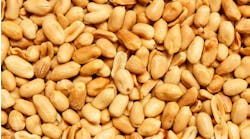In 2019, a coffee roaster with multiple locations in New York City asked a supplier of theirs, Patch Organics, to create a plant-based milk that was more sustainable than the products they were currently using.
The small company crafted a milk made from pumpkin seeds. The coffee roaster loved how the pumpkin milk worked in lattes and started ordering it regularly.
“Demand outpaced our ability to make enough for the ever-increasing weekly orders,” says Patricia Trongone, Patch Organics’ founder. The company found a co-packer to handle manufacturing and now offers five ready-to-drink flavors of the "milk": Original, Chocolate, Mocha Cold Brew Coffee, Pumpkin Spice and Ginger Turmeric.
Patch Organics’ use of pumpkin seeds is on-trend for food processors seeking to add nutritional value to their products, as seeds and nuts are loaded with vitamins, minerals, protein and other nutrients and are not difficult to incorporate into processed foods.
“Remember that the jobs of these plant parts – nuts and seeds, including cereals, which are seeds of grasses – is to make a new plant,” explains Julie Miller Jones, an emeritus professor of nutrition at St. Catherine University in St. Paul, Minn., and a member of the Grain Foods Foundation’s Scientific Advisory Board. “Therefore they are all packed with nutrition … and can add taste and texture, variety, and the wonderful nutrients they contain.”Less common seeds and nuts on the rise
Pumpkin seeds have long been found in trail mix and bagged alone, but today they are among the less common seeds and nuts being incorporated into processed food.
Another company that incorporates pumpkin seeds into their products is UK-based Honeybuns. The company uses the seeds in flapjack and granola bar mixes.
“We lightly toast them first, to release their nutty flavor before mixing them in with oats, fruit, syrup and oil,” explains Emma Goss, the company’s founder. “Nutritionally, pumpkin seeds are a powerhouse, providing relatively high levels of protein, ‘good fats,’ including omega-6 fatty acids, and antioxidants.”
Another less commonly used seed/nut is flax, which is primarily grown in Europe and Russia.
“Flax is high in fiber, both soluble -- which can impact the rate of blood glucose entry and may help control cholesterol—and insoluble, which increases fecal bulking, makes stools more fluid by pulling in water, and helps reduce constipation,” Miller Jones says. The seed also contains alpha linoleic acid, which is associated with lower risk of heart attack and stroke.
Honeybuns uses flax in its baked goods for both nutritional value and taste.
“Golden flax is one of our ‘go-to’ building block ingredients,” Goss says. “We use it in combination with ground almonds to create our signature biscuit bases. Flax provides a lovely depth of flavor compared to more neutrally flavored gluten-free flours such as potato and maize flour.”
Hemp seed is another less common seed now being used in processed food. Like flax, hemp contains alpha linoleic acid, Miller Jones says, as well as gamma linoleic acid, which is known as an anti-inflammatory. Hemp also contains magnesium, iron, zinc and vitamin E.
“Hemp has the right mix of amino acids to make it a complete protein or useful for pairing with grain proteins,” Miller Jones says. However, hemp may lose some nutritional potency if processed at temperatures above 350 degrees F, she adds.
Pairing hemp with grain protein is exactly what Sfoglini Pasta does with its Hemp Radiators pasta. Organic hemp flour is the second ingredient, after semolina flour, in this pasta. “Organic hemp is… subtly nutty, delicious, and works beautifully with everything from a rich sauce to a simple bowl with butter and parm,” the company’s website declares.
Chia seed, perhaps best known for its use in 1970s craze “Chia Pets,” also can add nutrition to processed food. Chia is high in fiber, especially soluble, gummy fiber, Miller Jones says. That characteristic may affect the blendability of dough containing chia, but it also makes chia potentially useful as a thickener or smoother in liquid applications.
Hello Puddin’ Chia Co. uses chia in its four varieties of chia pudding: Chocolate, Strawberry, Blueberry and Coffee. The puddings also include mushrooms to boost immunity.
More common seeds/nuts grew during COVID
The growing use of less common seeds and nuts in processed food does not mean familiar examples are being used less often. In fact, COVID powered the use of all nuts and seeds in processed food because of their overall nutritional benefits and the fact that they are often associated with “comfort food.”
“I think consumers are very smart and are looking for products that are more healthy,” notes John Sandbakken, executive director of the National Sunflower Assn. “That was especially true with COVID. And people ate more at home, which is a key part of the demand for sunflower products.”
Ground sunflower kernels, sugar and salt and the only ingredients in Sunbutter. The product comes in six retail varieties, including Creamy, No Sugar Added, Organic and Chocolate. The company also offers 16-lb. and 44-lb. pails of the product for commercial applications.
Jennifer Williams, marketing director for the California Walnut Board and Commission, also observed a jump in nut consumption during the pandemic. She says a meat replacement made with walnuts, legumes and spices was particularly popular.
“The singer Lizzo posted a great video of her using walnut-based meat on her TikTok and that got people really interested,” Williams says. “For plant-forward eating, there’s been a rise of people looking for clean-label meat substitutes, without the ingredients you can’t pronounce. Walnut meat is spices, beans or another legume and walnuts, that’s it.”
Williams explains that the texture of walnuts – they have a “bite” but are slightly softer than other nuts – makes them ideal for meat substitutes.
Azar Nut Co. makes a walnut-based meat substitute branded It’s Nature. The company, whose clients are primarily in foodservice, offers the product in Chorizo Seasoned and Italian Seasoned varieties.
“Walnuts offer amazing nutritional benefits by providing antioxidants and omega-3 fats, contribute to reduced inflammation and improved heart disease risk factors,” Azar’s website explains. “Culinary experts will appreciate the adaptability and allure of the rich, buttery and flavorful interior that walnuts will add to any recipe.”
Williams says walnut butter is also growing in popularity. For example, Well Nut Farms offers retail walnut butter in three varieties, Original, Maple and Salted Caramel.
“Walnuts have been an underutilized nut that have primarily been used as a secondary ingredient,” Well Nut Farms’ website explains. “Our focus has been to bring all of the amazing health benefits and rich nutty flavor of Walnuts into a must-have butter. Walnuts are the star ingredient in our walnut butters, nearly 90 percent are walnuts.”
Walnut butter is also available in commercial quantities for use in other processed foods, Williams says, though it hasn’t been widely adopted yet.
“As walnut butter becomes more prevalent, I imagine we’ll see the butter more in other products,” Williams says. “If someone wanted to use it now, such as in a bar, they would have a leg up.”
From a food processing perspective, Williams says it’s important to remember that the omega-3 in walnuts makes them more susceptible to spoilage when exposed to heat.
“You want to toast them right before you use them and keep the air away,” she says. “Keeping the air out will help increase the shelf life of the product.”
Cashews are an important ingredient in some processed foods, too. For example, Hong Kong-based Gafell uses cashews in place of butter in bechamel sauce. The sauce is used in the company’s Impossible Lasagna frozen entrée.
“We soak the cashews in water with 1% salt overnight, then we blend them together with water in a high-speed blender,” says Tommy Leung, the company’s president. “We then cook the cashews together with tapioca starch to thicken and season the sauce with nutritional yeast, garlic powder and onion powder.”
Gafell’s bechamel sauce contains more protein than traditional bechamel sauce and is high in plant-based fats, Leung explains. “Of course the biggest benefit is that it is 100 percent plant-based,” he adds.
A company that uses both walnuts and cashews in their products is Eat Nice Foods. For example, the filling in the company’s Meaty Walnut Ravioli starts with organic cashews, organic walnuts and organic sundried tomatoes.
Pecans are another popular nut used in processed foods. Each ounce of pecans provides 3g of protein and 3g of fiber, plus 12g of monounsaturated fat and 2g of saturated fat, says Alex Ott, executive director of the American Pecan Council.
Traditionally pecans have been used as chopped pieces – think of butter pecan ice cream and toppings on pecan cookies – but today they are also used ground into a pecan meal. For example, Blue Diamond Pecan Nut-Thins Crackers use pecan meal.
“Pecans are among the lowest in carbs and highest in fiber among tree nuts,” Ott says. “With their naturally sweet taste, buttery texture and satisfying crunch, pecans are a deliciously nutrient-dense nut.”
Nuts and seeds are essential ingredients for many processed foods, and the nutrition they add has been especially noteworthy during this past year. As innovative food manufacturers seek new products and ingredients, the use of nuts and seeds will continue to grow.


